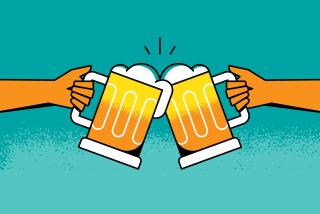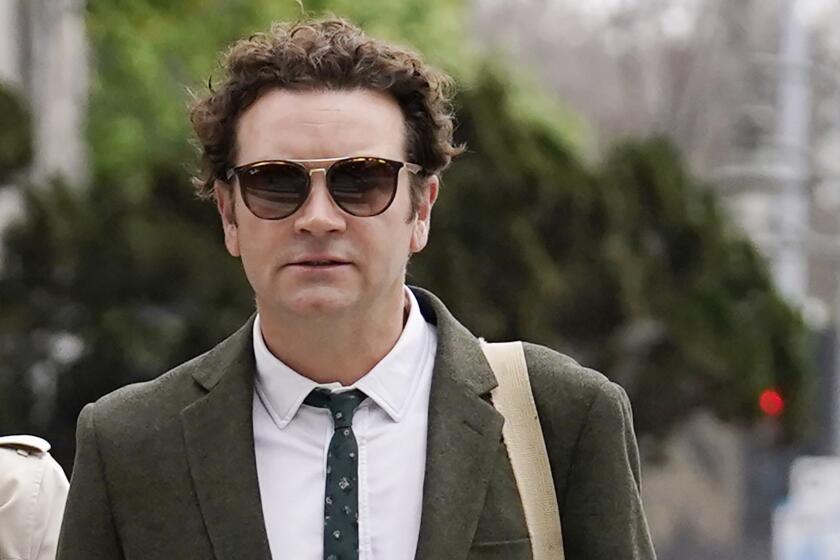Helping others is the religion
SAN DIEGO â Maybe it was the rain pelting Balboa Park. Maybe it was the toll of so many years on the streets, measured in missing teeth and weathered skin, a deep scar running up a taut belly. Whatever the reason, the man they call Dollar Bill said he was thinking that maybe it was time to find a place to live.
âIâm tired of the streets, baby doll,â he told Estreanda Fulford.
âAnd theyâre probably tired of you,â Fulford replied.
Fulford, a social worker for San Diego County, is in daily contact with the homeless, the formerly homeless and the soon-to-be homeless. But this encounter was not part of her job -- not her paying job, anyway. Fulford spends 30 to 40 hours a week volunteering as the leader of a ministry for homeless people for the Rock Church, a fundamentalist mega-church in Point Loma that is making its mark as a powerhouse of community service as well as evangelism.
The Rock says it contributed 615,000 hours of service to the community last year, including 166,000 hours for the benefit of local government in San Diego. The Rock estimates the value of its âmayorâs hoursâ -- projects it says were identified by San Diego Mayor Jerry Sanders -- at $2.6 million.
For 2010, it has set a goal of 700,000 hours, 200,000 of them for the city.
âItâs so simple,â said Miles McPherson, a former San Diego Chargers defensive back who founded the Rock 10 years ago and is its senior pastor. The goal, he said, is to âjust do something about the pain and brokenness of the world.â
Religious institutions have always been at least nominally concerned with social welfare. From small community churches to vast organizations like the Salvation Army, Jewish World Service and Catholic Charities, they have helped to sew patches in the social safety net.
The Rock hardly stands alone, but it does stand out.
âI think this last year that theyâve ... taken their volunteering and engagement in the community to a whole new level,â said Scott Thumma, a researcher who studies mega-churches for the nonprofit Pew Forum on Religion and Public Life. âThe last couple of years of recession have really concentrated the efforts of a lot of these mega-churches.â
Pastor Rick Warren of Saddleback Church in Lake Forest, one of the largest evangelical churches in the country, oversees social service efforts that reach around the globe. In a brief interview, he said his church has been âfeeding thousands of peopleâ during the recession. Of the Rock, he said: âWeâre doing the same thing. Weâre just not talking about it.â
McPherson does talk about it, at every opportunity. He has written a book, âDo Something! Make Your Life Count,â that lays out his philosophy.
McPherson turned 50 in March and looks as if he could still be a nimble presence on a football field. He was drawn to youth ministry after his NFL career, and from there it was a natural step to establishing his own church.
Tall and rangy, with a self-deprecatory sense of humor and a wardrobe filled with neatly pressed jeans and open-necked shirts, he has a casual charisma that seems to personify his church. There is, too, something of an athleteâs sensibility to his ministry, which places a higher premium on action than on words.
âLook around you,â he writes. âWeâre facing economic chaos, endless wars, AIDS, famine, ecological ruin, political corruption -- the list is endless. Your neighbors are in desperate need of love and a helping hand.â
Those are words that ring hollow in some quarters. In 2008, McPherson campaigned in support of Proposition 8, which banned same-sex marriage in California. Then last spring, he stood behind Miss California Carrie Prejean, a member of the Rock, after she shook up the Miss USA contest with a declaration that gay and lesbian couples should not marry.
âWe got hate e-mails -- hundreds of them,â McPherson said. âBut you gotta do what you gotta do.â He said Proposition 8 was âa marriage issue for us, not a gay issueâ and insisted that the church is nonjudgmental about its gay and lesbian âbrothers and sisters.â
You wonât find many openly gay members of the Rock, but it is otherwise diverse and inclusive, drawing some 13,000 people -- black, white, Latino, Asian -- to Sunday services in its church megaplex in a repurposed military building in Point Loma. (The church uses weekly attendance to count its flock; it does not have formal membership.)
It is an informal yet tightly controlled environment, watched over by a large and hyper-vigilant security force. The crowd skews young and casual; the service is heavy on music and video, light on dogma. At its center is McPherson, whose sermons are folksy and humorous, yet peppered with deadly serious moments of fundamentalist faith.
âHeâs going to come back any time,â he tells his congregation, referring to Jesus, âand weâve got to get busy, because people are going to go to hell.â
The Sunday service is meant to launch people on the real work of the church, which is in the community. Everyone is expected to pitch in. Funding comes from donations.
Homelessness, cancer, gangs, child abuse, hunger, addiction, domestic violence, eating disorders, unemployment, deaf foster children, strippers -- the church seems to have a ministry for every conceivable social ill or need. And it is about to expand, with plans for a network of 195 international missions, capitalizing on the global reach of its Internet site.
There are those who wonder if the Rockâs real agenda might be advancing its own growth and brand of evangelism.
âI commend them for whatever they do,â said the Rev. M.A. âMacâ Collins of St. Markâs Episcopal Church in San Diegoâs City Heights neighborhood. But, he added, âMy guess is, a lot of this stuff is stuff that has the primary purpose of conversion.â
Typically, Rock ministries have no strings attached, but there is an evangelical undercurrent. The Rock volunteers see this not as self-serving but as an effort to save souls.
Their primary motivation, McPherson said, is to do as Jesus would have done.
âI buy that, actually,â said Jo Anne Schneider, an anthropologist at the University of Maryland at College Park who studies social service outreach by churches.
âItâs usually very theologically based,â she said. âFor Jews and Muslims, thereâs a responsibility for community thatâs codified into the religion.â For Protestants, there is a motivation to be Christ-like, she said: âThe service is the theology.â
Christ-like is not the description that springs to mind when Raymond Barron gets to talking about his past. âI was just more violent than anything,â Barron said, hunched in the back of a car heading to a notorious gang gathering spot. âI didnât have any problem shooting anybody. I didnât have any problem stabbing anybody. I was sort of the enforcer.â
Barron is an imposing figure, a muscular guy with wrap-around shades, a goatee and slicked-back hair. One arm is stamped with a tattoo that says âChristian.â
Thatâs the new Raymond Barron, the one who gave up a good construction job so he could be his own boss and have more control over the hours he spends as a Rock volunteer. Barron helped launch the Rockâs gang outreach ministry, which is still finding its feet. He sees an urgency to the work, which isnât just about saving souls but about saving lives.
The core of the gang ministry is a bunch of guys like Barron, former gang members who say, almost to a man, that they reached a point at which they were just tired of life on the streets.
Now they go out in search of people like their old selves. Sometimes, they say, it goes well; they make connections, and the pews on subsequent Sundays may contain some newcomers with interesting neck tattoos.
Other times, their efforts are more hapless, like the evening they spent looking for gang members but found only fellow Christians.
âYou seen this?â Rock volunteer Steve Daigle said to one young man lounging in front of a music store with a group of other teens. Daigle showed him a copy of a McPherson book, â21 Jump-Start.â
âI got a copy of it,â the young man said. When Daigle looked surprised, the teenager gestured toward the music store. âDude,â he said, âthis is a Christian music academy.â
The gang ministry is one of the efforts that the Rock lists in its âmayorâs hours,â ostensibly in support of the Police Department. Some of the projects listed are clearly not for the benefit of city government; foster care programs, for instance, would benefit San Diego County, prison programs would benefit the state.
Rachel Lang, a spokeswoman for the mayor, said the Rock is just one of many congregations helping Sanders in his goal of âmaking San Diego a safe and enjoyable place to live.â
On Saturdays, Estreanda Fulford oversees the Rockâs Church Without Walls, which attracts a congregation of largely homeless people who attend for prayer and free food and coffee.
Superficially, Fulford would appear to have nothing in common with Dollar Bill, the homeless man she is trying to help. She is 24; he is 53. She is black; he is white. She is college educated and employed; he is neither one.
But Fulford, like so many Rock volunteers, has a personal connection to this work. Her parents, she recounted, were drug addicts who became homeless, spending years on L.A.âs skid row while Estreanda was raised by a grandmother. She has a childhood memory of making food with her grandmother, then going out onto the streets to give it to her parents.
When she began working with the homeless in San Diego, âI didnât see a homeless person,â she said. âI saw my mother and my father.â
As she spoke, rain splashed through the boughs of an overarching tree. The Church Without Walls service had just ended. People were milling about, eating sandwiches and pastries, talking about the sermon delivered by Rock volunteer Mike McNeil, who also leads a food ministry called Heavenly Kitchen.
âThereâs no judging out here,â Fulford was saying. âIf you fall down, thereâs no pointing fingers. You can pray for me too -- Iâm not better than you are. We minister to each other.â
Dollar Bill, whose real name is William E. Hinton Jr., wandered over. He told Fulford he had grown tired of the streets. They began talking about what to do.
They went back and forth, Dollar Bill worrying about how he could pay for rent and food, Fulford telling him it could be done. âYou donât need to worry about anything else, you just need to get your place,â she said. âNext week, weâre going to get together and come up with a game plan.â
âOK, sweetheart, weâll do it,â Dollar Bill said finally.
That would be the perfect ending, but life isnât so neat. Weeks later, the weather was better and Dollar Bill was still on the streets. âHeâs still not ready to make that transition,â Fulford said. She was there, though, ready to help, if and when he wanted it.
More to Read
Sign up for Essential California
The most important California stories and recommendations in your inbox every morning.
You may occasionally receive promotional content from the Los Angeles Times.










